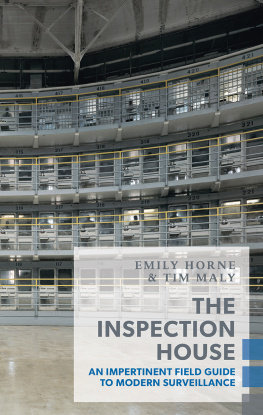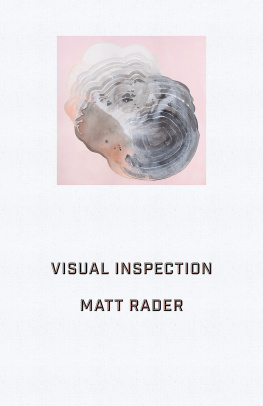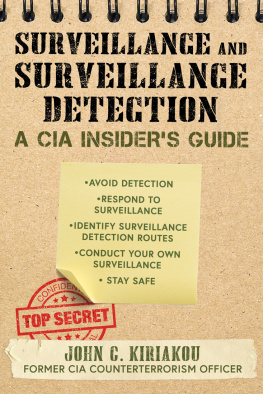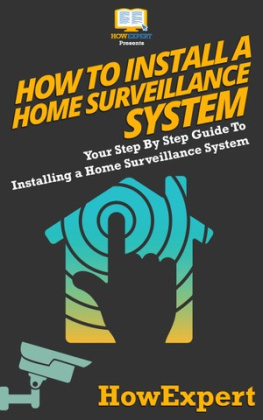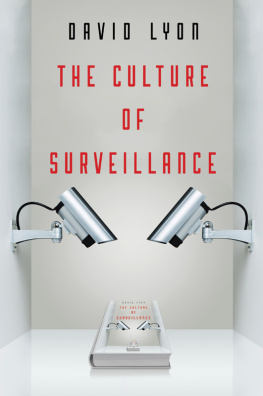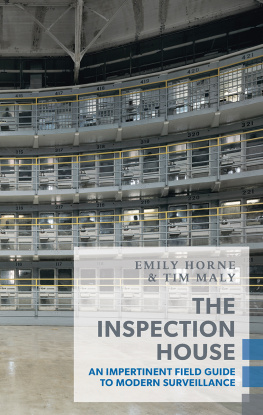copyright Emily Horne & Tim Maly, 2014
first edition
Published with the generous assistance of the Canada Council for the Arts and the Ontario Arts Council. Coach House Books also gratefully acknowledges the support of the Government of Canada through the Canada Book Fund and the Government of Ontario through the Ontario Book Publishing Tax Credit.
LIBRARY AND ARCHIVES CANADA CATALOGUING IN PUBLICATION
Horne, Emily, 1979-, author
The inspection house : an impertinent field guide to modern
surveillance / Emily Horne and Tim Maly.
(Exploded views)
Issued in print and electronic formats.
ISBN 978-1-55245-301-8 (pbk.).
eBook development: WildElement.ca
1. Electronic surveillance. 2. Social control. 3. State, The.
4. Privacy, Right of. I. Maly, Tim, 1978-, author II. Title.
III. Series: Exploded views
JC596.H67 2014 323.4482 C2014-904401-1
The Inspection House is available as an ebook: ISBN 978 1 77056 389 6.
Purchase of the print version of this book entitles you to a free digital copy. To claim your ebook of this title, please email sales@chbooks.com with proof of purchase or visit chbooks.com/digital . (Coach House Books reserves the right to terminate the free download offer at any time.)
To Whom It Ought to Concern,
This is a field guide to the rich terrain of the panopticon. Can you correctly identify a panopticon? Knowing more about surveillance enhances our experience and helps us to share encounters with friends and family.
Getting Started
Whos watching you? Make a list of all the people or institutions that are tracking you. Are you being observed directly? Are there CCTV cameras in your neighbourhood? Are your whereabouts and purchases being logged by your phone provider? Do you use a computer to access the internet? Are you carrying any credit cards or smart cards? Did you have to fill out a time sheet or report to a supervisor today? Did you hand in any assignments? Have you interacted recently with the police or emergency services personnel? Does your country conduct domestic surveillance operations? Do any other countries on your planet conduct foreign surveillance operations? Do you have friends or family who wonder where you are? Has your region been mapped? Do you ever pay bills or taxes? Do you use local utilities? Do you have any subscriptions? Do you have a to-do list? Do you track your fitness or diet goals?
Can you watch back? Once you have completed the activity, go back over the list and mark which of those agents you can observe in return. Can they see more about you, or can you see more about them? Is there anyone you can talk to about your experience of being watched?
About This Book
A field guide is a book designed to help the reader identify wildlife, architecture or other objects and networks of natural or human occurrence. It is designed to be brought into the field or local area, where such objects and networks exist to help the reader distinguish between similar objects and networks.
In general, serious and scientific field identification books feature keys to assist with identification. This book does not include identification keys. Nor does it include drawings or paintings to assist the reader with a visual inspection. A visual inspection is hardly the point. This is a field guide to a conceptual terrain.
About This Terrain
The world is webbed in vast physical and virtual networks. The world has always been webbed in networks, but the latest networks are particularly vast and particularly fast.
Telecommunications and electronics (now cheap, thanks to robust global logistical networks) have mixed with business needs and an atmosphere of fear around real and imagined threats from activist, criminal and terrorist organizations (illicit networks) to encourage the implementation of sprawling surveillance networks. A significant proportion of the population regularly carry devices that, as a matter of regular operation, log their locations and activities. An even greater proportion conduct their daily affairs across a network of services that also log everything as a matter of course.
When people reach for a metaphor to understand our present condition, many grab hold of the panopticon. Often, their usage doesnt go much deeper than the meaning of the word (in Greek, pan meaning all , optikon meaning seeing ). This book will help you explore further.
The Inspection House has three central players, none of which are human. The first is a collection of letters written by British philosopher Jeremy Bentham, describing his initial design of the Panopticon. The second is Discipline & Punish , a book written by Michel Foucault that reinterprets Benthams Panopticon as an emblem for a particular way of organizing society. The third is our strange present condition. We will use each of these characters to try to understand the other two.
Following in the footsteps of our first two players, this book is architectural, though it contains very little architecture. Both Bentham and Foucault treat buildings as machines for disciplining, tools for altering behaviour. Their descriptions tend to be idealized or vague. We have chosen specific sites to illustrate the messy interface between power and history. Yesterdays ideologies are frozen into todays architecture. Todays ideologies must contend with or replace that inherited built environment.
How to Use This Book
The structure of the book is: seven longer chapters, each focused on a particular site and organized in a way that loosely mirrors the argument of Discipline & Punish . Within and between the chapters are enriching asides and related material. You do not need to read the book in order.
Use this guide to help you identify, classify and resist the panopticons and pseudo-panopticons you come across in your daily life. An understanding of the genus is critical to understanding the ecology of surveillance culture.
We wish you luck,
Emily & Tim
Morals reformed health preserved industry invigorated instruction diffused public burthens lightened Economy seated, as it were, upon a rock the Gordian knot of the Poor-Laws are not cut, but untied all by a simple idea in Architecture!
Jeremy Bentham, Panopticon; or,
The Inspection-House
Bentham was surprised that panoptic institutions could be so light: there were no more bars, no more chains, no more heavy locks; all that was needed was that the separations should be clear and the openings well arranged.
Michel Foucault, Discipline & Punish
1
Millbank Prison
T he 1850 Hand-Book of London , a travellers guidebook, describes Millbank Prison like this: A mass of brickwork equal to a fortress, on the left bank of the Thames, close to Vauxhall Bridge It was designed by Jeremy Bentham, to whom the fee-simple of the ground was conveyed, and is said to have cost the enormous sum of half a million sterling.
Millbank was still under construction when it opened in 1816. It was built on the marshy banks of the south side of the Thames, close enough to London for convenience but isolated enough to avoid complaints from neighbours. The layout was complex: a central tower was surrounded by a hexagon of walls, each segment of which was the base of a further pentagon of walls, with open exercise yards inside them. Each yard was watched over by its own four-storey tower. Seen from above in maps of the day, the prison resembles a barbed flower with six pentagonal petals, surrounded by a wall and moat that enclose the full sixteen-acre site.


